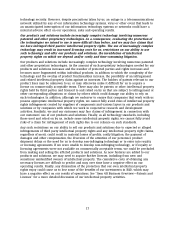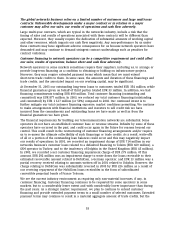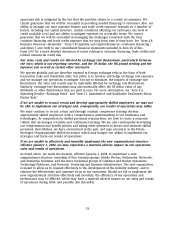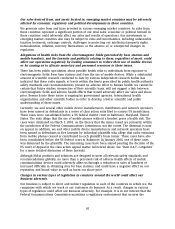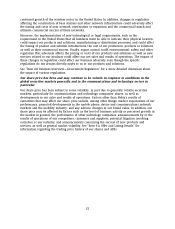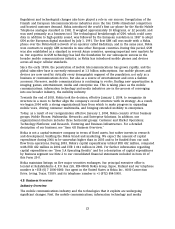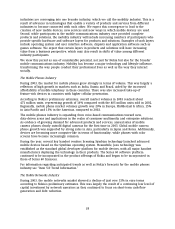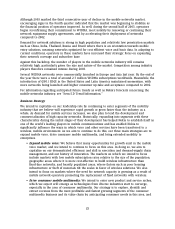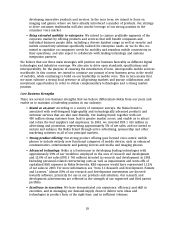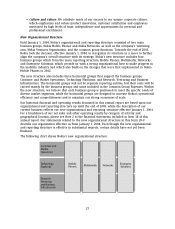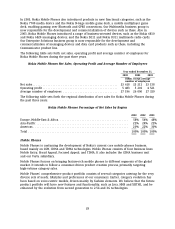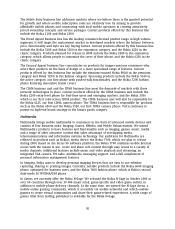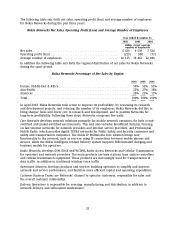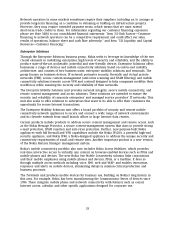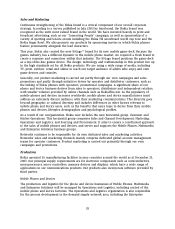Nokia 2003 Annual Report Download - page 26
Download and view the complete annual report
Please find page 26 of the 2003 Nokia annual report below. You can navigate through the pages in the report by either clicking on the pages listed below, or by using the keyword search tool below to find specific information within the annual report.Although 2003 marked the third consecutive year of decline in the mobile networks market,
encouraging signs in the fourth quarter indicated that the market was beginning to stabilize as
the financial position of operators improved. As well, during the second half of 2003, operators
began reconfirming their commitment to WCDMA, most notably by renewing or continuing their
network equipment supply agreements, and by accelerating their deployment of networks
compared to 2002.
Demand for network solutions is strong in high population and relatively low penetration markets
such as China, India, Thailand, Russia and Brazil where there is an orientation towards mobile
entry solutions, meaning networks optimized for cost efficient voice and basic data. In adapting to
current conditions, operators in these markets have increased their strategic focus on expanding
their network coverage and subscriber base.
Against this backdrop, the number of players in the mobile networks industry still remains
relatively high, particularly given the size and nature of the market. Competition among industry
players therefore remained intense during 2003.
Several WCDMA networks were commercially launched in Europe and Asia last year. By the end of
the year there were a total of around 2.7 million WCDMA subscriptions worldwide. Meanwhile, the
introduction of GSM / EDGE in the United States and Latin America maintained momentum, with
more networks being launched and higher consumer up-take and acceptance compared to 2002.
For information regarding anticipated future trends as well as Nokia’s forecasts concerning the
mobile networks industry, see ‘‘Item 5.D Trend Information.’’
Business Strategy
We intend to capitalize on our leadership role by continuing to enter segments of the mobility
industry that we believe will experience rapid growth or grow faster than the industry as a
whole. As demand for mobile services increases, we also plan to lead the development and
commercialization of high capacity networks. Historically, expanding into segments with these
characteristics during the initial stages of their development has helped Nokia to establish itself as
one of the world’s leading players in mobile communications and has enabled Nokia to
significantly influence the ways in which voice and other services have been transferred to a
wireless, mobile environment. As we aim to continue to do this, our three main strategies are to:
expand mobile voice, drive consumer mobile multimedia, and bring extended mobility to
enterprises.
•
Expand mobile voice:
We believe that many opportunities for growth exist in the mobile
voice market, and we intend to continue to focus on this area. In doing so, we aim to
capitalize on our demonstrated efficiency and skill in execution and demand-supply chain
management, and our history of innovation. The markets on which we intend to focus
include markets with low mobile subscription rates relative to the size of the population,
geographic areas where it is more cost-effective to build wireless infrastructure than
fixed-line networks, and heavily populated areas, where factors such as poor housing
infrastructure or theft of materials tilt the scales in favor of wireless solutions. We also
intend to focus on markets where the need for network capacity is growing as a result of
mobile network operators promoting the replacement of fixed networks with wireless.
•
Drive consumer mobile multimedia:
We intend to enter new product and service niches,
which we expect will emerge as technologies from diverse industries start to converge,
especially in the area of consumer multimedia. Our strategy is to explore, identify and
extract revenue from the most profitable and fastest growing segments of the consumer
multimedia business and its value chain by anticipating consumer needs in this area, and
25




